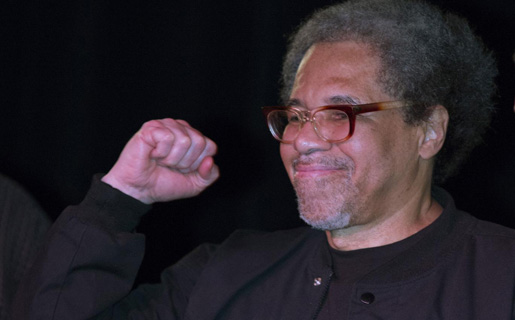
CHICAGO — Season Four of the Netflix original series Orange is the New Black premiered last month, revealing an onslaught of dramatic plot twists for Litchfield’s most beloved prisoners. Yet all the drama and criticism of the most recent season skimmed over a hot-button issue. This season, audiences followed along as Sophia, played by transgender activist Laverne Cox, is sent away to solitary confinement. While in the “SHU” Sophia is left with little communication to the outside world and is forced to resort to inflicting self-harm so as to draw attention to her desperate situation.
While there are numerous references in Hollywood that bring attention to the cruel practices of solitary confinement (“Shawshank Redemption” and “The Longest Yard” are two examples) the reality of such methods exceed that of any fictional presentation. In many states, activist groups are seeking to eliminate the method altogether, seeing it as a form of legalized prison torture. Many organizations, such as the national prisoners’ rights network Black & Pink, are rallying to dismantle abusive practices in prison systems and advocate for the abolishment of solitary confinement. Black & Pink calls for liberation and justice while also publicizing the plight of LGBTQ prisoners. Its network of chapters includes many prisoners and “free world” allies who support the total dismantling, or “abolition,” of what they term the prison industrial complex.
Cruel methods
Eddie Willis, a member of the Chicago chapter of Black and Pink, was previously imprisoned is now an outspoken advocate against solitary confinement practices. Willis, who spoke to People’s World about serving part of an eight-year sentence at Kane County Jail in St. Charles, Illinois. While inside he was thrown into “the hotbox” for extensive periods of time. He recalls having been in solitary for ten days before he pleaded with the facility guards to allow him a shower. In response an officer pepper sprayed Willis, filling up the tiny space with toxic fumes; making it virtually impossible to breathe. “I’ll never forget it,” says Willis, recalling the experience. “The officer said he would be back in ten minutes, and that if I was still alive when he got back, he would let me take a shower then.” Choking on the gases from the pepper spray, Willis said he had no choice but to stick his head in the toilet and continuously flush as he struggled to regain oxygen.
The incident led to a lawsuit, which was eventually settled out of court. Despite this, Willis remained scarred by the trauma. He said that other witnesses and officers did not attempt to help him, despite the fact that some must have been aware of what was occurring. “I didn’t have anyone,” said Willis “they are all together at the end of the day, and you’re just a number.”
According to the American Civil Liberties Union (ACLU), numerous human rights violations occur in the prison system, but they are especially likely to occur when an individual is isolated from the general population. It is nearly impossible for most prisoners in solitary to contact anyone on the outside, and statistics have shown that the use of confinement as a punishment is inflicted mostly on inmates who fit specific profiles. Younger inmates, inmates without a high school diploma, and lesbian, gay, and bisexual inmates were more likely to have spent time in restrictive housing chambers, such as solitary, than older inmates, inmates with a high school diploma or more, and heterosexual inmates. The legality of such methods are questionable as it has been found that solitary confinement is linked to a variety of mental health problems. According to a report from the watchdog group Solitary Watch, a 2000 study found that inmates held in solitary developed mental illnesses at nearly twice the rate of those held in the general population (28% vs. 15%). Yet such findings have not slowed its use. A Senate panel found in 2014 that of the 2.3 million people incarcerated in the U.S., 80,000 had been held in some type of special detention housing such as solitary confinement.
Frank Chapman, a national field organizer in Chicago’s Alliance Against Racist and Political Repression, spoke with People’s World about his own experiences in the prison industrial complex. He was first locked up in 1961, when many prisons were still legally segregated, and served 14 years. During his time there he was thrown into solitary for nine months, which he says is a relatively short time given the current patterns of incarceration. “Things have gone backwards – they now keep people in there for years. My nephew was in solitary confinement for 10 years.”
Longer and longer periods
The extensive stints that Chapman speaks of may be unfathomable to the ordinary person, but for victims of the prison industrial complex the horrors of such legalized torture are a reality. In April the Guardian released a profile on Albert Woodfox, who spent 43 years in an isolation cell in Louisiana, the longest recorded time in solitary in the U.S. Woodfox was a former Black Panther activist who was accused of murdering a prison guard – a claim for which he has continuously insisted he was framed. It was not uncommon for the U.S. to use severe forms of punishments on political prisoners, particularly those associated with radical black and brown organization, which raises questions about the selective manner in which such methods are applied. Such practices have been linked to long-running psychological and emotional trauma. Woodfox himself has stated that there were moments since his release in which he has felt that he needed to be back in a cell, as the chaos of the outside world created a sensory overload for him.
Human rights groups globally are beginning to condemn the use of isolation as a tool in prisons. In 2011 the United Nations’ expert on torture, Juan E. Méndez, called on all countries to ban solitary confinement, proclaiming it a “harsh measure” which contradicts prisons’ stated goal of rehabilitation of inmates. Méndez, who is a lawyer and a human rights activist, proclaimed that the use of solitary was unnecessary except in very exceptional circumstances and for as short a time as possible. He also emphasized that in the case of children under 18 and people with mental disabilities the practice should be absolutely prohibited. Chapman agrees, reaffirming that the practice should be completely outlawed: “There is something really sick with the American prison system,” he says. “If you want to understand how ‘civilized’ a society is, you look at its prisons.”
Slow progress
Recently activists, along with a Chicago- based nonprofit legal organization specializing in prisoners’ rights, the Uptown People’s Law Center, pushed for a bill restricting the use of isolated confinement in correctional facilities in Illinois (HB 5417). The details of the bill specified that “a committed person shall not be placed in isolated confinement unless there is reasonable cause to believe that the committed person would create a substantial risk of immediate serious harm to himself, herself, or another.” It also provides that a prisoner shall not be placed in isolated confinement before receiving a personal and comprehensive medical and mental health examination conducted by a clinician. In order to pass, the bill would have to go through a process of committees in the state Senate, the whole Senate, the House, and be signed by the governor. But in this year’s legislative session, it was not called to a vote- it seems that there were insufficient representatives supporting it- and was subsequently killed before any progress could be made.
The political apathy of Illinois lawmakers here serves as a reminder of the manner in which prisoners are dehumanized and forgotten. Chapman says that there needs to be a larger national effort to dismantle the the prison industrial complex, saying: “We’ve got to liberate these people!”
Black and Pink has set up a fundraising page so that the public can not only continue to support folks on the inside, but also help individuals transition back into society after they have completed their sentences. They provide things such as transportation passes, temporary housing, clothing, toiletries, and additional medical necessities. Thanks to programs that have focused on rehabilitation, some individuals such as Eddie Willis have been able to re-establish themselves in society. Willis even recently started his own consulting business, and hopes to continue fighting against the injustices that prisoners face every day. Frank Chapman, similarly has channeled his experiences to continue advocating for those victimized by state-inflicted violence. “Solitary confinement is a cruel and unusual punishment,” he said. “And no person deserves to be treated that way, period.”
Photo: Albert Woodfox in New Orleans shortly after his release. | AP

MOST POPULAR TODAY


Zionist organizations leading campaign to stop ceasefire resolutions in D.C. area

High Court essentially bans demonstrations, freedom of assembly in Deep South

Afghanistan’s socialist years: The promising future killed off by U.S. imperialism

Communist Karol Cariola elected president of Chile’s legislature






Comments